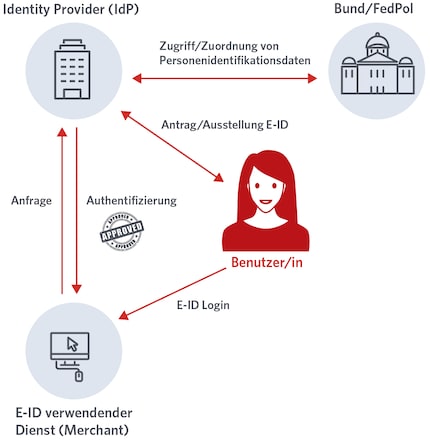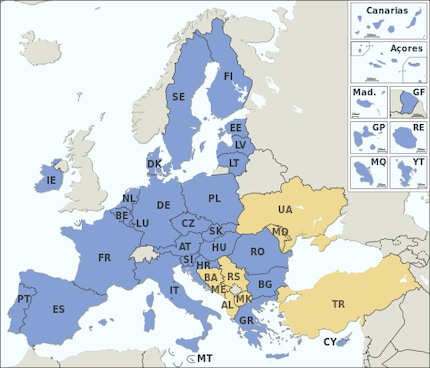
Background information
The new Swiss data protection law – what you need to know
by Florian Bodoky

Last week, Federal Councillor Elisabeth Baume-Schneider presented the e-ID project. From 2026, you should be able to download a valid and recognised Swiss identity card onto your smartphone and use it to prove your identity. This article summarises the main responses to the question of electronic identification.
The Confederation is making another attempt to introduce e-ID in Switzerland. You can download your electronic card onto your mobile phone and use it to identify yourself. The chances of this bill being accepted are much better than in the first attempt, because the Confederation will retain control over the eThe Confederation will retain control over the issuing and validation of the card and will not delegate the identification of residents to private companies, as explained by Federal Councillor Baume-Schneider. However, we will have to wait a little longer before we get to that point.
A few years ago, the Confederation launched a project to introduce an electronic means of identification. Unlike the current project, the electronic ID card would have been provided not by the Confederation itself, but on its behalf. Private companies would have been entrusted with this task.
A referendum was launched against this form of e-ID, or more precisely against the draft "Federal law on electronic identification services". The vote took place on 7 March 2021. 64.4 per cent of voters rejected the law. The role of private providers is seen as the stumbling block that led to the clear-cut rejection of this federal law. However, the reasons for this rejection have never been statistically calculated.
On 10 March 2021 - i.e. the week after the vote - six motions were tabled in favour of an e-ID (21.3124, 21.3125, 21.3126, 21.3127, 21.3128 and 21.3129). The parliamentarians clearly felt that the e-ID was a good idea, but that it should be overseen by the Confederationr. The Federal Council did what it had to do: on 26 May 2021, it instructed the Federal Department of Justice and Police (FDJP) to develop a state solution for the e-ID. The FDJP was assisted in this by the Federal Chancellery (FC) and the Federal Department of Finance (FDF). Following a public consultation, on 17 December 2021 the Federal Council presented the principles of this new e-ID
.

After consultation, the Federal Council adopted the message on 22 November 2023. The new draft still has some sticking points. In addition to the consultation procedure, regular exchanges are taking place between the project team set up by the Confederation and interested parties, including the groups that supported the project during the first vote on the e-ID. They were able to draft position papers and give their opinions. Among the comments made were that certain details of the law are not yet formulated in a sufficiently concrete way, or that certain essential points are missing altogether. I'll come back to this later.
An e-ID card serves the same purpose as a conventional ID card. It should enable you to identify yourself, when shopping online or in a shop, for example.
Or, the idea of the e-ID goes even further: to set up an ecosystem operating like Apple Wallett or Google Wallett and allowing use by cantons, municipalities and private individuals. In this way, you will be able to load your diplomas, certificates, medical prescriptions, tickets, etc. into the app.

At cantonal and communal level, it will be possible to order official documents online, such as a certificate of origin, an extract from the debt enforcement register or an extract from the criminal record. You will also be able to register with the Residents' Registration Office when you move in or out. The e-ID will enable you to identify yourself and register the necessary documents in the ecosystem.
No. Karin Keller-Sutter, Elisabeth Baume-Schneider's predecessor at the FDJP, had already promised that this would not happen (from minute 6:28).
The e-ID will not replace the physical ID. It will complement it.
According to the director of the Federal Office of Justice, Fedpol, which issues official identity documents, will receive no more data than it does at present. It will therefore be the same data as that required for a conventional ID card or passport, such as surname, date of birth, etc.
The Confederation followed three principles when drawing up the e-ID law and its technical implementation.
This is one of the questions that has not yet been definitively resolved. Anyone holding a Swiss identity card or passport will be able to apply for an e-ID. The same will apply to holders of a permit for foreign nationals in Switzerland. For the time being, it is still being investigated whether other groups of people could use an e-ID, for example, cross-border commuters, owners of second homes, diplomatic staff or undocumented migrants.
As soon as you do, the Confederation will publish a free app that will allow you to scan your classic ID card. Next, you will take a selfie, which will be transmitted to the server of the Federal Office of Police (fedpol) and validated. You will automatically receive your e-ID on your smartphone via the app. Those in charge have also decided that the Confederation will also take care of technical support.
Accessibility will be guaranteed. Many institutions would like recognised, independent bodies to monitor the Confederation and thus ensure that all technically possible measures will be taken to guarantee accessibility.
For the next five years, the Confederation is forecasting development and operating costs of CHF 182 million. Thereafter, i.e. from 2029, operating costs will amount to 25 million Swiss francs a year. However, use of the e-ID will be free of charge.
This is a point that has not yet been clarified. Various interest groups are calling for the e-ID to have the same period of validity as a physical identity card, i.e. ten years for adults. However, for reasons of data security, the period of validity may be shorter. In the current bill, it is up to the Federal Council to decide.
Probably yes. The Swiss e-ID will comply with international standards. The law is therefore formulated in a technology-neutral way.

This means that the law does not tie the development of the e-ID to any particular technology. This will enable the Confederation to adapt more quickly to new technological developments.
The Confederation expects the e-ID to be available from 2026. However, IT projects are often complicated. Problems that the Confederation had not foreseen may arise during development and slow down the process. But at the moment, you can expect the e-ID to be available in 2026.
As part of the development of this law, the Confederation organised regular video conferences with various interest groups. On these occasions, doubts about the law or the e-ID in general were expressed by the latter. The point most criticised was data protection. For example, the canton of Zurich and the Swiss Pirate Party fear that we could end up with what is known as over-identification. In concrete terms, as identification by e-ID will be very easy, you shouldn't have to identify yourself for things that didn't previously require identification or be asked to provide data that isn't necessary for a specific purpose, for example to secretly create your advertising profile. These critical voices demand that data be checked only once and that it cannot be recorded or reproduced.
Other sceptical voices find it too ambitious for the Confederation to develop and propose an ecosystem open to identity documents other than the e-ID. They feel that the Confederation should confine itself to its role, which is to issue official identity documents. Then there are players like GastroSuisse, who fear that verifying age in a restaurant will require a costly infrastructure. They therefore want individuals to be able to decide for themselves whether to accept identification via e-ID in addition to the classic ID card.
If you would like to read all the criticisms and questions, the Confederation has summarised them here for you.
The bill has been presented to Parliament. Parliament must accept it. As many interest groups came forward beforehand and criticised the draft, it is likely that those responsible will still have their work cut out.

If the law is passed and published by Parliament, it will be possible to launch an optional referendum. To do this, 50,000 valid signatures will need to be collected within 100 days. The people will then vote on the law. If no one launches a referendum or the collection of signatures fails, the law will come into force.
Headline photo: FDJPI've been tinkering with digital networks ever since I found out how to activate both telephone channels on the ISDN card for greater bandwidth. As for the analogue variety, I've been doing that since I learned to talk. Though Winterthur is my adoptive home city, my heart still bleeds red and blue.
Interesting facts about products, behind-the-scenes looks at manufacturers and deep-dives on interesting people.
Show all